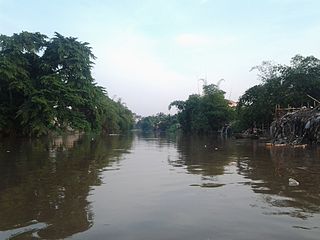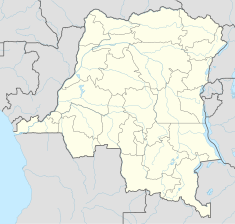
A water supply network or water supply system is a system of engineered hydrologic and hydraulic components that provide water supply. A water supply system typically includes the following:
- A drainage basin
- A raw water collection point where the water accumulates, such as a lake, a river, or groundwater from an underground aquifer. Raw water may be transferred using uncovered ground-level aqueducts, covered tunnels, or underground water pipes to water purification facilities.
- Water purification facilities. Treated water is transferred using water pipes.
- Water storage facilities such as reservoirs, water tanks, or water towers. Smaller water systems may store the water in cisterns or pressure vessels. Tall buildings may also need to store water locally in pressure vessels in order for the water to reach the upper floors.
- Additional water pressurizing components such as pumping stations may need to be situated at the outlet of underground or aboveground reservoirs or cisterns.
- A pipe network for distribution of water to consumers and other usage points
- Connections to the sewers are generally found downstream of the water consumers, but the sewer system is considered to be a separate system, rather than part of the water supply system.

The Boulevard du 30 Juin is a major 5‑km street in Kinshasa, Democratic Republic of the Congo (DRC). It is the city center's main transport artery, connecting the southern area of La Gombe with Kintambo and the Ngaliema to the west.
Dallas Water Utilities (DWU) is the water and wastewater service operated by the City of Dallas, Texas, in the United States. DWU is a non-profit City of Dallas department that provides services to the city and 31 nearby communities, employs approximately 1450 people, and consists of 26 programs. DWU's budget is completely funded through the rates charged for water and wastewater services provided to customers. Rates are based on the cost of providing the services. The department does not receive any tax revenues. Primary authority and rules for the department are listed in Chapter 49Archived 2006-10-04 at the Wayback Machine of the Dallas City Code.

The Régie de Distribution d'Eau, abbreviated as REGIDESO, is a state-owned utility company located on Boulevard Du 30 Juin, in the Gombe commune of Kinshasa, Democratic Republic of the Congo (DRC). It is responsible for producing and distributing water throughout the national territory, encompassing both urban and rural areas. Established in 1929, REGIDESO operates autonomously within the Department of Mines and Energy under the government of the DRC.

The Ndjili River is a river that flows from the south through the capital city of Kinshasa in the Democratic Republic of the Congo, where it joins the Congo River. It separates the districts of Tshangu and Mont Amba. The river gives its name to the Ndjili commune and to the Ndjili International Airport.

Although the Democratic Republic of the Congo (DRC) has Africa's largest freshwater resources, it is suffering from an acute drinking water supply crisis. The DRC has one of the lowest rates of access to clean drinking water in Sub-Saharan Africa and the world. Only 46 percent of the population had access to an improved drinking water source in 2012. Furthermore, the sanitation coverage was estimated at only 31 percent in 2012. Up to date and accurate information on water supply and sanitation services in the DRC is scarce. As a result of inadequate water supply and sanitation services, many inhabitants are suffering from waterborne diseases, including diarrhoea, typhoid, and cholera.
E.A Fairbairn Water Treatment Plant is a water treatment plant located next to the California State University, Sacramento campus. This water treatment plant, along with Sacramento River Water Treatment Plant on Sacramento River, provide approximately eighty five percent of Sacramento's drinking water. This treatment plant was recently renovated and completed in February 2019.
Katosi Water Works (KWW), also Katosi Water Treatment Plant is a water purification and distribution project in Uganda.

A water distribution system is a part of water supply network with components that carry potable water from a centralized treatment plant or wells to consumers to satisfy residential, commercial, industrial and fire fighting requirements.
Grand Katende hydroelectric power station is a hydropower plant under construction in the Democratic Republic of the Congo, with installed capacity of 64 megawatts (86,000 hp). When completed, it will be operated by the Congolese electricity utility company, Société Nationale d'Électricité (SNEL).
Busia Water Supply and Sanitation Project (BWSSP), also Busia Water Supply and Sewerage System is a water intake, purification, distribution and waste water collection and disposal system in Busia District, Uganda.
Kinshasa Thermal Power Station, also Kinshasa Plastics Waste–To–Energy Plant, is a planned plastics-fired thermal power plant in the city of Kinshasa, the capital of the Democratic Republic of the Congo, with an estimated population of 15 million inhabitants, as of August 2021. The waste-to-energy power station will, in the first phase, convert 200 tonnes of plastic waste everyday into "3,500 liters of industrial lubricants, 15,000 liters of diesel fuel, and three metric tonnes of char " on a daily basis. In addition, it will in the process, generate 96 MWh of energy, on an annual basis. The power generated will be sold to the Congolese electricity utility company Société Nationale d'Électricité (SNEL), for intergradation into the national electricity grid.
Sfax Desalination Plant is a sea water desalination plant under construction in the city of Sfax in Tunisia. The facility is under development by the Tunisian water utility company, National Company for the Exploitation and Distribution of Water (Sonede).
Gulu Water Supply and Sanitation Project (GWSSP), also Gulu Water Supply and Sewerage System, is a water intake, purification, distribution and waste water collection and disposal system in the city of Gulu, the largest urban centre in the Northern Region of Uganda. In October 2020, the Uganda government concluded Phase 1 of the improvement of water supply and sanitation in the city, with funding from the World Bank, KfW and the Government of Uganda. Phase 2 improvements are expected to start in 2021, with funding from the World Bank, KfW and the Commonwealth Development Corporation.
Moyo Water Supply and Sanitation System (MWSS), also Moyo Water Supply and Sewerage System is a water intake, purification, distribution and waste water collection and disposal system in Moyo Town and surrounding metropolis in Moyo District, Uganda.
Isingiro Water Supply and Sanitation Project (IWSSP), also Isingiro Water Supply and Sewerage System is a water intake, purification, distribution and waste water collection and disposal system in Isingiro District, in the Western Region of Uganda. The project is intended to meet the water supply and sanitation needs of 340,000 people of the 550,000 inhabitants of the district. The beneficiaries include the 100,000 occupants of Nakivale Refugee Settlement and the 32,000 occupants of Oruchinga Refugee Settlement. The work is to be carried out by the Uganda Ministry of Water and Environment through the parastatal utility company, National Water and Sewerage Corporation (NWSC). Funding, have been provided by the French Development Agency and the European Union.
Masaka–Mbarara Water Supply and Sanitation Project (MMWSSP), is a water intake, purification, distribution and waste water collection and disposal system in the cities of Masaka and Mbarara in the Central Region and the Western Region of Uganda. The project is intended to meet the water supply and sanitation needs of approximately 1,055,000 by 2030. The work is to be carried out by the Uganda Ministry of Water and Environment through the parastatal utility company, National Water and Sewerage Corporation (NWSC). Funding, have been provided by the French Development Agency and the European Union.
Rukungiri Water Supply and Sanitation Project (RWSSP), also Rukungiri Water Supply and Sewerage System, is a water intake, purification, distribution and waste water collection and disposal system in the town of Rukungiri, in the Western Region of Uganda. When completed, the system is expected to supply 9,600 cubic meters (9,600,000 L) of water daily, to about 120,000 people in the town of Rukungiri and neighboring communities in Rukungiri District and to parts of Ntungamo District. The infrastructure development project is being jointly funded by the World Bank and the Government of Uganda.
The Mamelles Desalination Plant is a sea water desalination plant under construction in the city of Dakar in Senegal. The facility is under development by the government of Senegal, with financial support from the Japan International Cooperation Agency (JICA). The Senegalese national water company, SONES, is developing the project on behalf on the Senegalese government, and the Japanese private company Nippon Koei, is developing the project, on behalf of JICA. Construction started in June 2022, at a budgeted cost of €200 million and an expected output of 50,000 cubic meters (50,000,000 L) of desalinated potable water every day in the first phase, expandable to 100,000 cubic meters (100,000,000 L) daily, in the second phase.
Karenge Drinking Water Supply System (KDWSS), also Karenge Water Supply System is a water intake, purification, and distribution system in Rwanda. The system supplies water to parts of the capital city of Kigali and the neighboring Rwamagana District.







